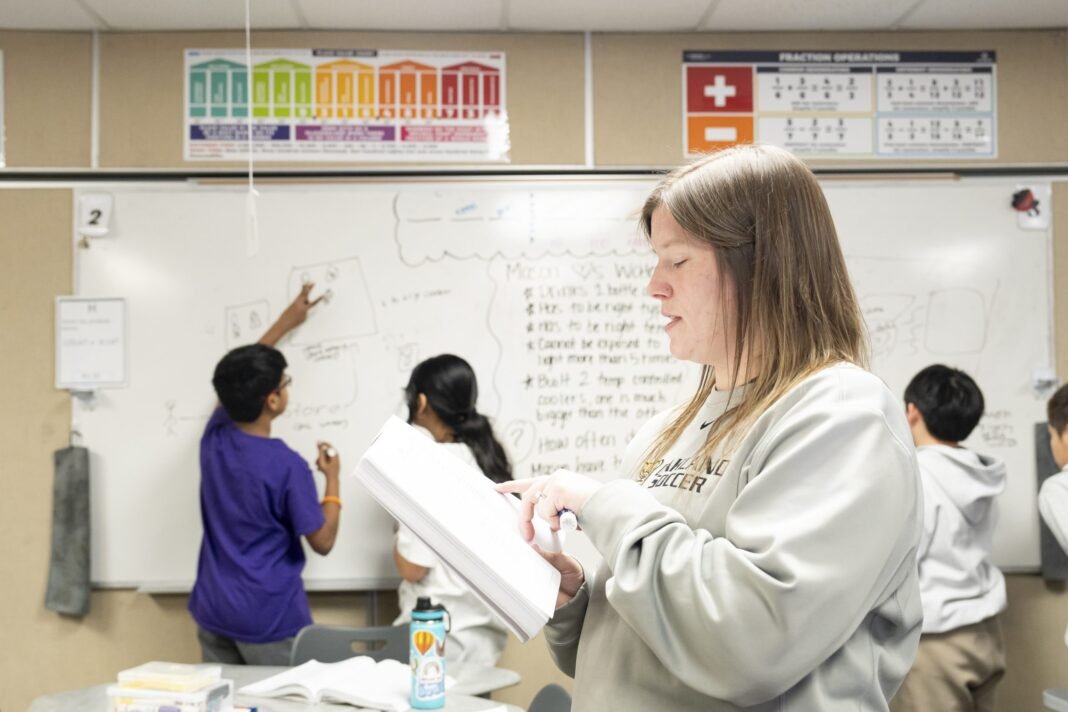Math education is living under a spell. Most classes and curricula operate under a pervasive and unspoken assumption; its benefits are widely accepted, but its flaws are all too hidden.
The assumption is that you learn math by solving strings of successively harder problems. At each stage, the teacher decides how hard to make the problems; that is, where to set the “difficulty dial.” The ideal is to gradually turn the difficulty dial from left to right, easy to hard, at just the right speed. For example:
First: Add 19 + 12. Then, later: Add 1989 + 1272.
First: Solve 2x + 1 = 9. Then, later: Solve 2x + 9 = 1.
First: Graph y = x2. Then, later: Graph xy + 25 = x2 + y2.
There’s truth in this way of thinking, but when I start treating that slice as a whole loaf — when I catch myself thinking of where to set the difficulty dial as the only choice, or even the primary choice, that a math teacher faces — that’s when I slap my face, dump ice water on my head and write two crucial inequalities on my hand:
Easy ≠ Welcoming.
Difficult ≠ Challenging.
Focusing on “easy” vs. “difficult” can become a trap. The two appear to stand opposed, and so teachers can fall into the idea that we must pick one or the other.
But who really cares about “easy” and “difficult”? They are only proxies for two higher virtues, the actual qualities of successful instruction.
Related: Widen your perspective. Our free biweekly newsletter consults critical voices on innovation in education.
First, math class should be welcoming. Students need to feel comfortable in the intellectual work of mathematics. Teachers need to help them feel capable not just of solving an “easy” or dumbed down problem, but of tackling the real stuff.
Second, math class should be challenging. It should sharpen and deepen students’ thinking. They should master new skills and practice solving unfamiliar problems.
Unlike easy vs. difficult, welcoming and challenging aren’t opposites. We don’t need to choose between them. The best math instruction braids the two together, in puzzles that are clear yet subtle. A good math lesson, like a good sudoku, can welcome and challenge students simultaneously — welcome them by challenging them.
As a classroom teacher, one of my favorite instructional moves is “give me an example.” At any level of K-12 mathematics, it offers agency and freedom — and it’s easy to come up with such questions.
Give me two numbers that are both below 100, but that definitely add up to more than 100.
Give me an equation whose solution you don’t know, but you can quickly tell that the solution is not a whole number.
Give me an equation in two variables that makes it impossible for one of the variables to be 10.
Asking such questions invites diverse responses. They’re hard to grade in a standardized, objective way. That’s why textbooks and question banks tend to steer clear of them — and that’s why teachers must not.
Mathematical truth may be black and white, but mathematical thinking is not. We need questions that draw out all the shades and hues of thought.
When I taught sixth grade, one of my students’ favorite activities was writing questions for each other. At the end of each unit, I’d designate two piles on my desk: one for straightforward practice questions (the kind easily placed on a difficulty dial) and one for novel problems or open-ended puzzles (including, but not limited to, “give me an example” questions).
Nothing is more welcoming, or more challenging, than the chance to welcome and challenge one another.
When I first taught high school precalculus, my students couldn’t make heads or tails of piecewise-defined functions. Then I lost a whole lesson to a ramble about federal income taxes — and saw their heads perking up after weeks spent slouched on their desks.
That led me to a suitably welcoming and challenging task: Design your own income tax system. Give a table of brackets and rates; give the tax bill for a specific worker in each bracket; and, trickiest of all, give the tax bill as a piecewise-defined function of income.
I’m not sure if the project was easier or more difficult than the exercises we’d been doing. But it excited them more, and pushed them harder. It welcomed and it challenged students.
Since then, projects have become a staple of my teaching — not as a replacement for quizzes and tests, but as a necessary complement.
Related: Why schools are teaching math word problems all wrong
Kids, being human, prefer easy tasks over difficult ones. When the homework is too difficult, they mutiny; when it’s too easy, they shrug and smile.
But on some deeper level, they don’t want math to be easy. They want it to be rewarding.
I saw this the first time I taught AP calculus. In precalculus the year before, my teaching had certainly not inspired them. But now, as 12th graders, they’d name-drop their math class in the hallway, as if they’d befriended a minor celebrity.
“Can’t talk, guys. I’ve got to do the calculus.” “Hey, have you started the calculus?” “Ugh, I was up so late last night doing calculus.”
I say this with affection, having written a book on the stuff, but calculus has little obvious appeal. It’s unnecessary for daily life and irrelevant to most professions.
Despite this, my students thirsted for it. For these kids in Oakland, calculus’s challenge wasn’t a turn-off. It was a badge of honor.
There’s no way to make calculus easy — but that doesn’t mean it can’t be welcoming.
Ben Orlin is a math teacher who can’t draw. He is the author of “Math with Bad Drawings” (2018), “Change Is the Only Constant” (2019), “Math Games with Bad Drawings” (2022) and, most recently, “Math for English Majors” (September 2024). He has previously taught middle and high school, and now teaches at Saint Paul College.
This story about teaching math was produced by The Hechinger Report, a nonprofit, independent news organization focused on inequality and innovation in education. Sign up for Hechinger’s weekly newsletter.


